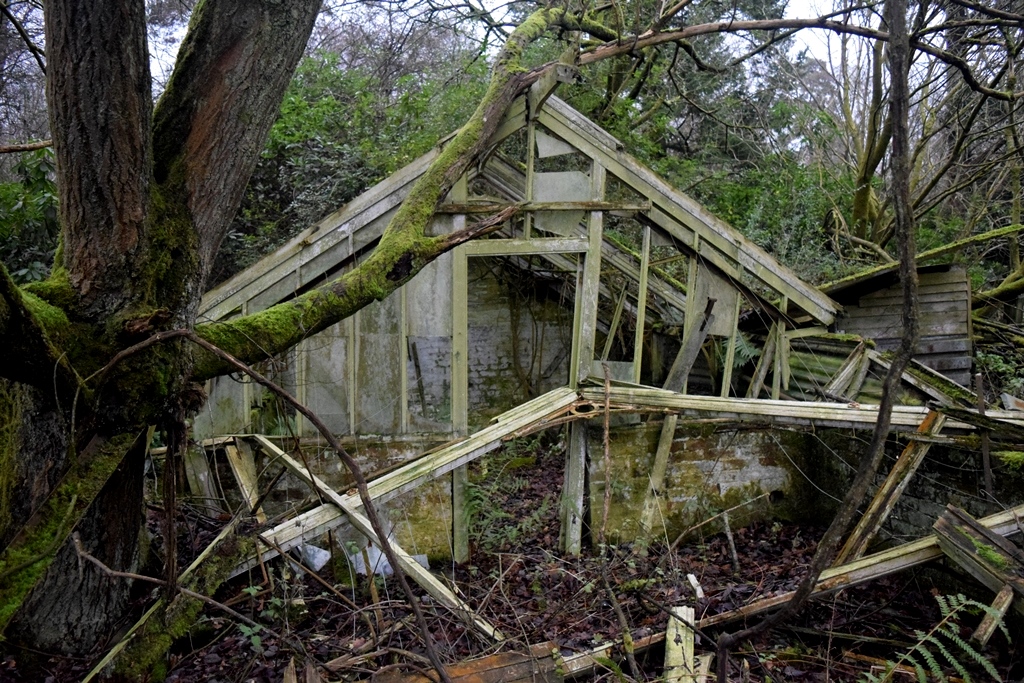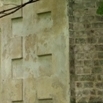Lost Gardens
Page Updated: November 2020
Over the past decade, I have spent much time seeking out lost gardens - mostly what I call stately gardens: the landscaped grounds of country houses now fallen into decay. Finding these places often takes hours of research and a lot of hacking through undergrowth and although I have often been scratched, stung and bruised on these adventures, for me, the excitement of discovery as a crumbling ice house emerges from the rhododendron bushes or an overgrown greenhouse is spotted beneath the brambles is always worth the effort required.
The gallery below is a collection of pictures taken in gardens across Wales and Southern England to illustrate some of the features typically found in the country house garden from 1740-1939. It will be added to as and when more gardens are rediscovered.

Broadmoor Tower, Surrey stands hidden on a densely wooded hill above the Tillingbourne, possibly part
of the landscape park created in the 1740s for Theodore Jacobsen, a Dutch merchant resident in England.

Manmade waterfall part of the landscape park at Tillingbourne, Surrey.

Damsons grow beside the old walled garden at Ends Place, Sussex. The house was demolished in the 1980s

Derelict greenhouse in Balcombe Forest, Sussex. The estate seems to have been developed between the wars.

Collapsed greenhouses at Honeywood House, Surrey, once the country retreat of noted eccentric
Lady Katharine Carnegie, Viscountess Tredegar. The house is now a nursing home

Pet Cemetery, somewhere in Surrey. Wealthy owners often had elaborate graveyards set up close to
the house for beloved dogs, cats, or even horses.
[click images below to expand & enlarge]


















|
The British landscape garden has its origin in the eighteenth century, when 'landscape architects' such as William Kent, Lancelot 'Capability' Brown and Humphry Repton began to plan parks and gardens along naturalistic lines with the same attention to detail as the architects who built the houses they surrounded.
The 'English Landscape Garden' soon became the fashion in Europe and by the 1780s, jardins � l�anglaise could be found as far afield as Munich and St. Petersburg. By the second half of the nineteenth century, a stately garden could stretch to several acres and might include formal features such as terraces and neatly-manicured lawns as well as more 'romantic' elements such as rockeries, fern groves and 'wild gardens.' In larger properties, these grounds would merge, apparently seamlessly (in reality a hidden wall or ditch kept livestock from roaming the gardens), with rolling parks grazed by herds of deer or pedigree cattle.
During the Victorian era, advances in technology and a craze for plant collection saw ever more ambitious and exotic features introduced, including Japanese gardens, palm and orchid houses.
Although these gardens were mostly designed with leisure in mind, they were also expected to provide food for the table: the walled kitchen garden with its high walls, glasshouses, potting sheds and neatly arranged rows of vegetables is one of the most easily recognisable features of the larger country garden. Some of the grander examples included hothouses for growing fruits such as melons and pineapples, and a sizeable estate might also boast an orangery for growing citrus fruits.
The decline of the stately garden closely followed that of the country house itself, but where many country houses survived the demolition and neglect so widespread during the twentieth century their gardens often did not. During the twentieth century, the great care with which the gardens had been tended often proved to be their downfall: labour was no longer cheap or plentiful and gardens often became neglected as family fortunes diminished. In addition, many houses were sold by their cash-strapped owners to become schools, hospitals or convalescent homes whose trustees hadn't the resources or inclination to maintain their extensive grounds.
Home
| |